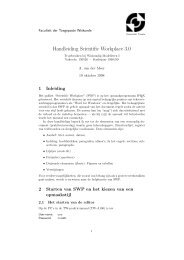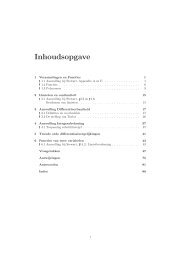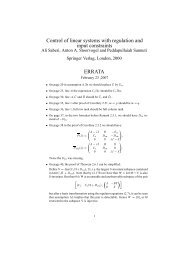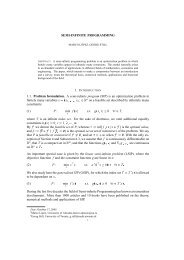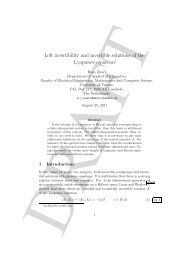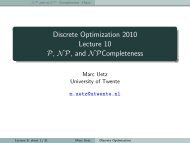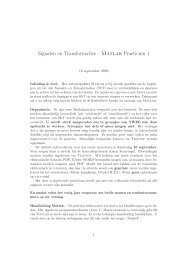Dispersion and dissipation error in high-order Runge-Kutta ...
Dispersion and dissipation error in high-order Runge-Kutta ...
Dispersion and dissipation error in high-order Runge-Kutta ...
Create successful ePaper yourself
Turn your PDF publications into a flip-book with our unique Google optimized e-Paper software.
Tak<strong>in</strong>g the Lagrange polynomials as trial functions <strong>and</strong> us<strong>in</strong>g the mapp<strong>in</strong>g X k (ξ), we<br />
approximate the solution at the N nodal po<strong>in</strong>ts with<strong>in</strong> each element as<br />
q k (x, t) ≈ q k N(x, t) =<br />
N∑<br />
q k i (t) (L i (x)) 2d ∈ Pp(Ω d k ),<br />
i=1<br />
where q k N (x, t) is the f<strong>in</strong>ite element approximation, <strong>and</strong> qk i (t) represents the solution at<br />
nodal po<strong>in</strong>t x j ∈ Ω k .<br />
The distribution of the nodes is a key issue for the properties of the <strong>in</strong>terpolation, especially<br />
for very <strong>high</strong>-<strong>order</strong> approximations. It is best measured by the Lebesgue constant<br />
associated with the Lagrange polynomials go<strong>in</strong>g through a particular set of nodes. The<br />
Lebesgue constant shows just how close a given polynomial approximation is to the best<br />
polynomial approximation. The most popular choices for nodes <strong>in</strong> spectral/hp element<br />
methods are the Fekete po<strong>in</strong>ts [34] <strong>and</strong> the electrostatic po<strong>in</strong>ts [15, 17]. It should be noted<br />
that although the Fekete po<strong>in</strong>ts have the best <strong>in</strong>terpolation properties (lowest Lebesgue<br />
constant) <strong>in</strong> a triangle for <strong>order</strong>s p ≥ 9, no distribution for a tetrahedron has so far been<br />
provided. An (almost) optimal distribution of the electrostatic nodes, however, is given<br />
for a triangle <strong>in</strong> [15] <strong>and</strong> for a tetrahedron <strong>in</strong> [17]. Moreover, the electrostatic po<strong>in</strong>ts also<br />
perform slightly better for <strong>order</strong>s p ≤ 8 <strong>in</strong> triangles. The distribution of these nodes <strong>in</strong><br />
the st<strong>and</strong>ard triangle is shown <strong>in</strong> Figure 1 for <strong>order</strong>s p = 2, 4, 6, 10. We also note that<br />
the nodal distributions <strong>in</strong> a triangle <strong>and</strong> tetrahedron with an L 2 -norm optimal Lebesgue<br />
constant were determ<strong>in</strong>ed <strong>in</strong> [7] <strong>and</strong> [8]. However, these nodes, <strong>in</strong> contrast with the Fekete<br />
<strong>and</strong> electrostatic po<strong>in</strong>ts, do not have an edge distribution which can be identified with<br />
Gauss-Lobatto-Jacobi po<strong>in</strong>ts. We refer to [25] for further overview on nodal (<strong>and</strong> modal)<br />
spectral/hp methods.<br />
To formulate the discont<strong>in</strong>uous Galerk<strong>in</strong> scheme, we first <strong>in</strong>troduce the local <strong>in</strong>ner<br />
product <strong>and</strong> its associated norm on Ω k as<br />
∫<br />
(u, v) Ω k = u · v dx, ‖u‖ 2 Ω<br />
= (u, u) k Ω k<br />
Ω k<br />
<strong>and</strong> on its boundary ∂Ω k as<br />
∫<br />
(u, v) ∂Ω k = u · v ds.<br />
∂Ω k<br />
We multiply (7) with the local test function φ ∈ Pp d(Ωk ), chosen to be the same <strong>in</strong>terpolat<strong>in</strong>g<br />
Lagrange polynomials L i (x) for the trial basis functions, drop the superscript k<br />
<strong>and</strong> <strong>in</strong>tegrate by parts over element Ω k to obta<strong>in</strong> the cont<strong>in</strong>uous weak formulation<br />
(<br />
Q ∂q )<br />
∂t , φ − (F,∇φ) Ω k = − (ˆn · F, φ) ∂Ω k , ∀Ω k ⊂ Ω K . (9)<br />
Ω k<br />
We then replace the cont<strong>in</strong>uous variable q with its discrete counterpart q N , <strong>and</strong> the<br />
exact flux F with the numerical flux ̂F to account for the multi-valued traces at the<br />
element boundary. F<strong>in</strong>ally, <strong>in</strong>tegration by parts for the second time results <strong>in</strong> the discrete<br />
formulation<br />
(<br />
Q ∂q N<br />
∂t<br />
) ( [<br />
+ ∇F N , φ = ˆn · F − ̂F<br />
] )<br />
, φ . (10)<br />
Ω k ∂Ω k<br />
6



